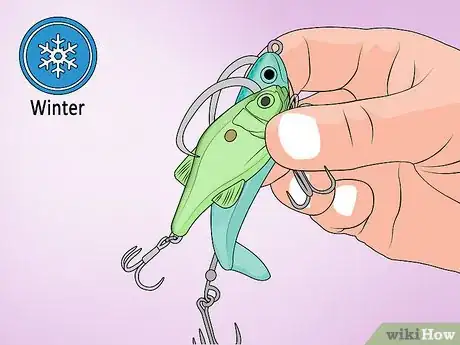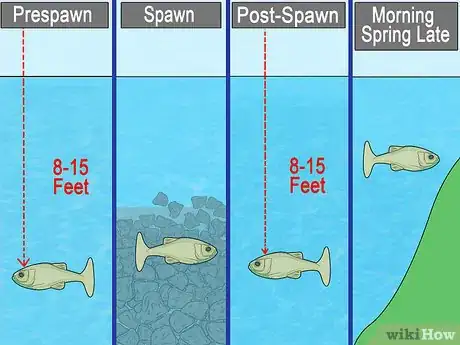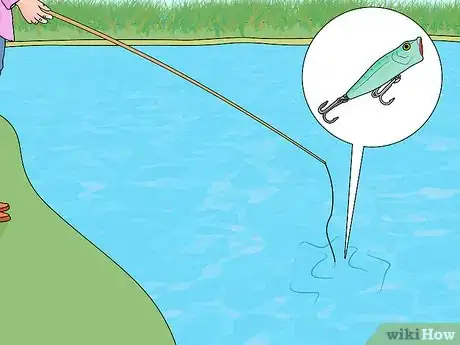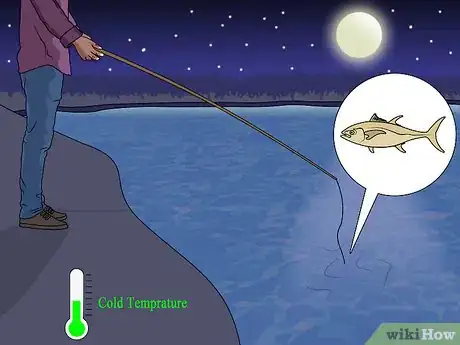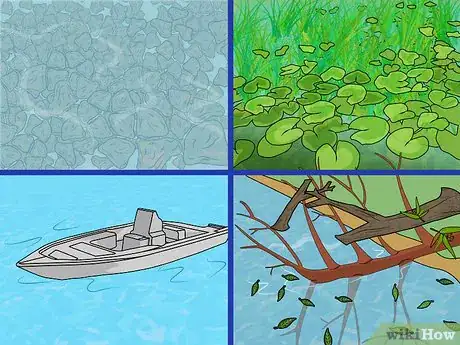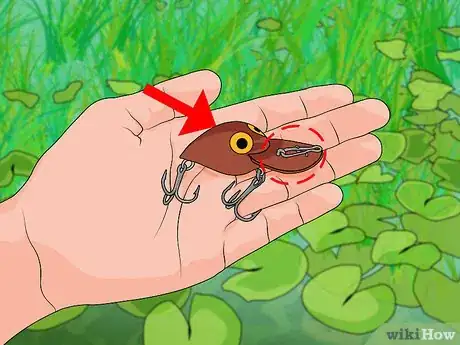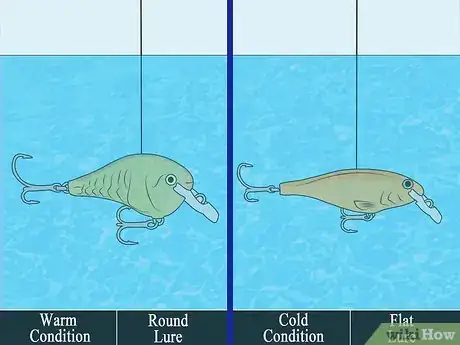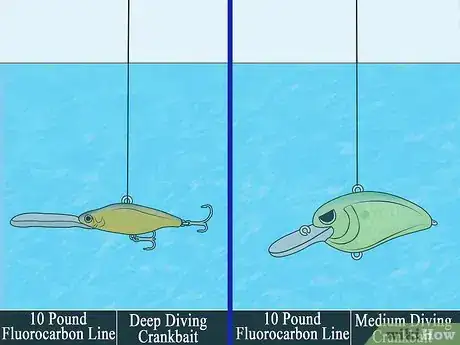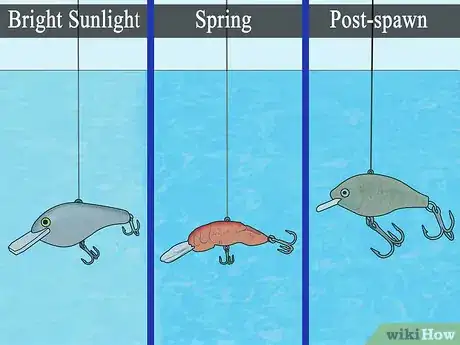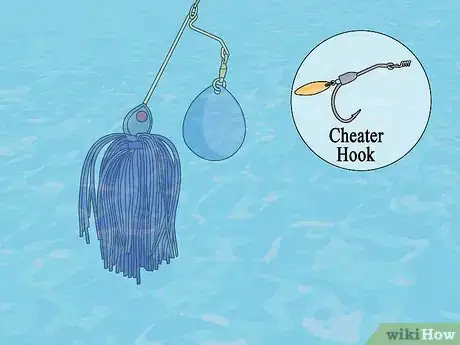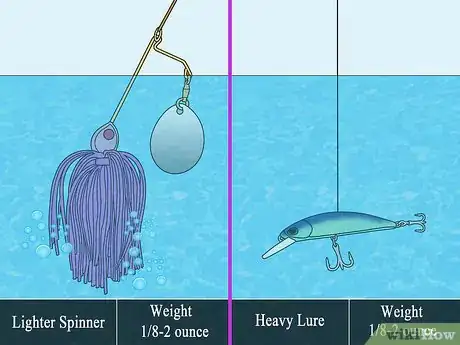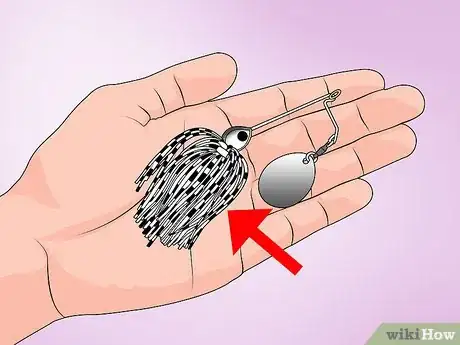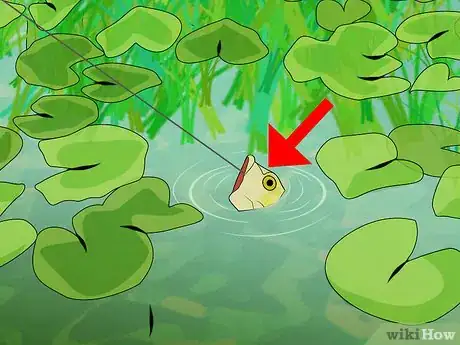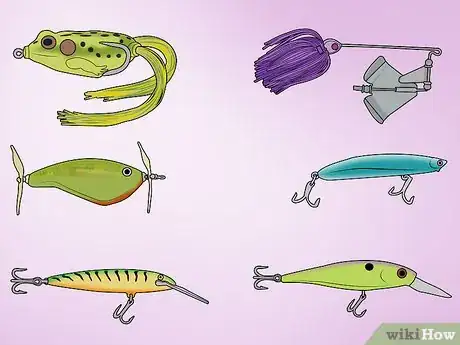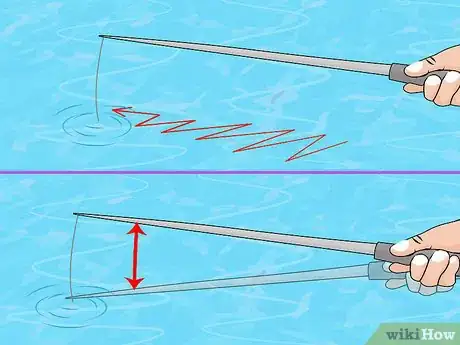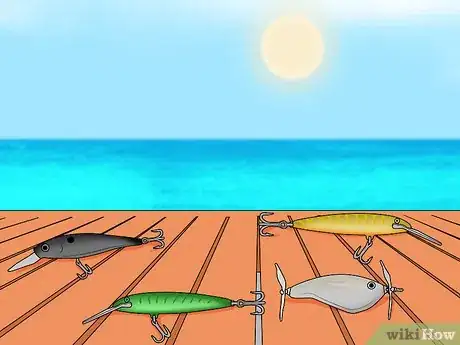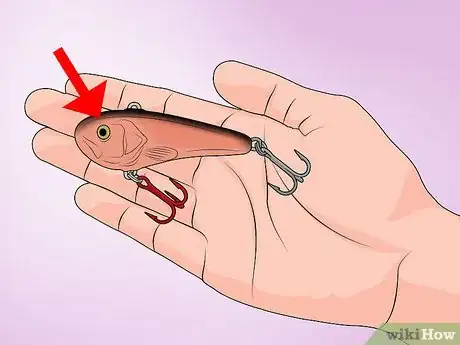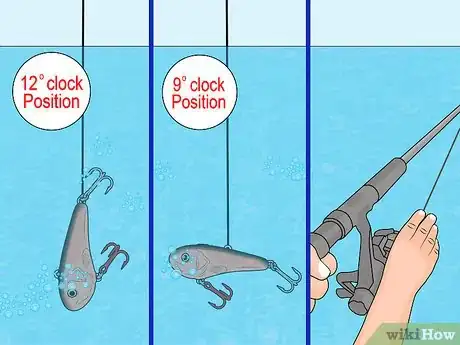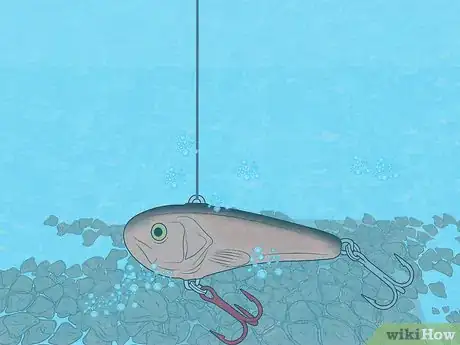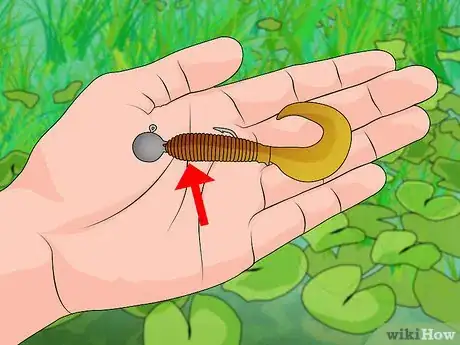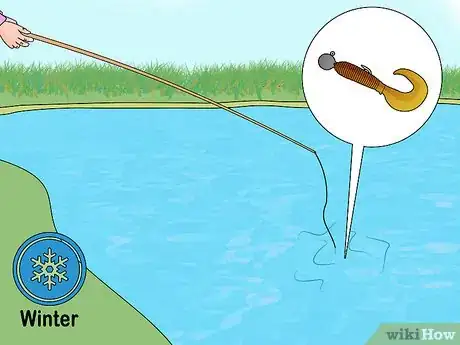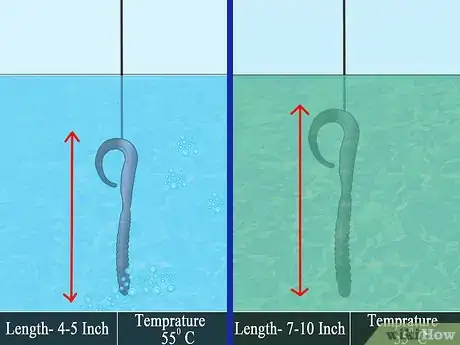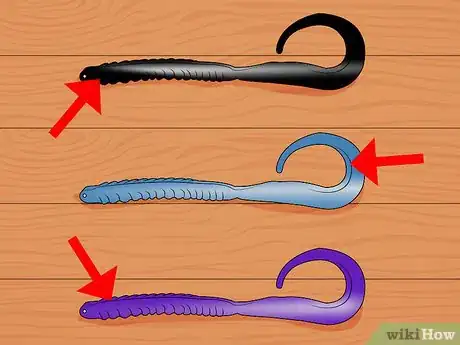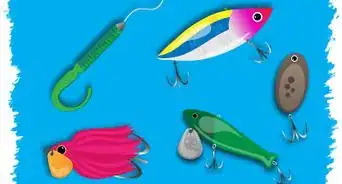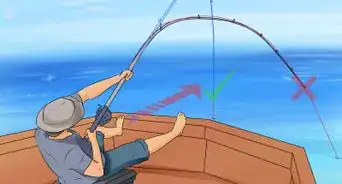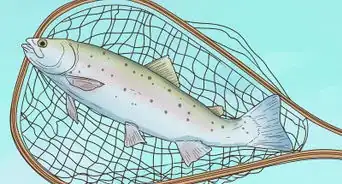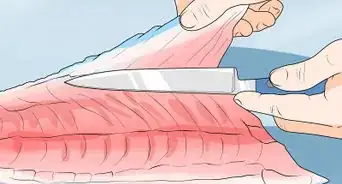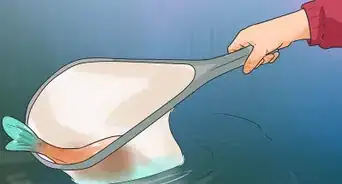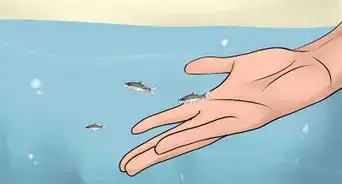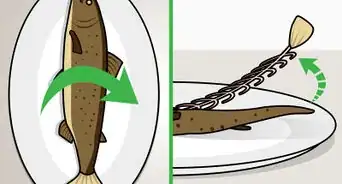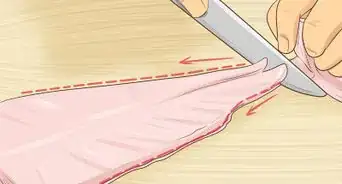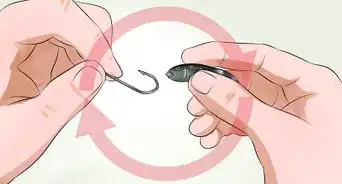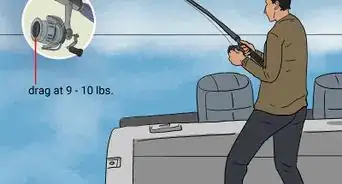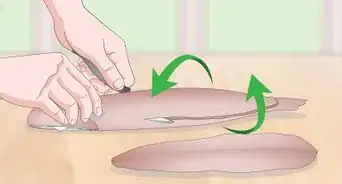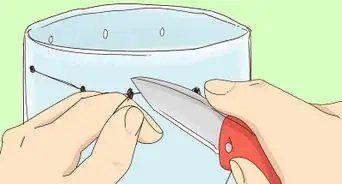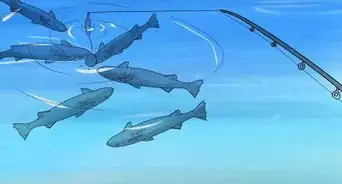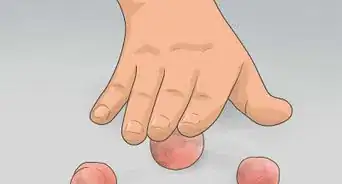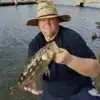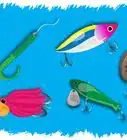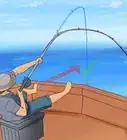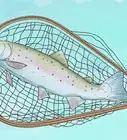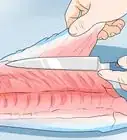This article was co-authored by Michael Reynolds. Michael Reynolds is a Professional Fishing Instructor and the Owner of Long Beach, California Fishing Lessons by Michael Reynolds. In his over 40 years of fishing experience, Michael has become very knowledgeable about the variety of fishing methods and techniques. He is passionate about sharing his knowledge with beginners to experienced anglers. Michael has been guiding and teaching fishing for over five years and is licensed and bonded with the Department of Fish and Wildlife (DFW).
wikiHow marks an article as reader-approved once it receives enough positive feedback. In this case, 100% of readers who voted found the article helpful, earning it our reader-approved status.
This article has been viewed 442,949 times.
Fishing for bass can be overwhelming as you can choose from thousands of lures. The more you understand the habits of bass, the more effective you can be when choosing your lure. Break down the science of bass fishing with these main types of lures: crankbaits, spinnerbaits, topwaters, plastic/rubber lures, and jigs.
Steps
Assessing Fishing Conditions
-
1Use slow moving baits and slow moving presentation when fishing in the Winter or the cold. With lower temperatures, bass will not expend much effort and will only bite when your lure is immediately within their strike zone.
-
2Break Spring into 4 segments called pre-spawn, spawn, post-spawn, and late Spring. Pre-spawn means that bass will be around the 8–15 feet (2.4–4.6 m) depth, spawn means they will move up to their spawning beds, post-spawn means they will move back down to 8-15 feet, and the late spring has bass moving towards the shore early in the morning and out towards structures later.
- Pre-spawn occurs when waters climb to around the 45 degree mark. Spawn occurs when water is between 55 and 65 degrees. Post spawn occurs at different times and doesn't happen to an entire lake due to differences in water temperatures. Late Spring is basically the beginning of summer when temperatures climb upwards of 80 and 90 degrees.
Advertisement -
3Fish along the shore early in the morning during the Summer and off of structures during the day. When fishing in the Summer, bass will be closer to the shore early in the morning to feed then move into open water around creek channels and structures.
- They will school together and feed on shad near the top of the water so it's best to use topwater, plastics, jigs, and even lipless crankbaits.
-
4Fish the first cool night of the Fall. As the temperature drops in the Fall, bass will be feeding closer to shore but will show more erratic behavior. The first cool night of Fall is a good time to look for a feeding frenzy as bass prepare for the upcoming cold months.[1]
-
5Analyze the terrain. Depending on the weather and which phase of their mating cycle they are in, bass may like to stay close to certain areas or hide within debris. Vegetation, rocky bottoms, shallow flats, fallen trees, structures, bushes and grass can all provide ample places to cast. Research the swimming habits that may correspond to the time and place that you are fishing.
Fishing with Crankbaits
-
1Utilize crankbaits when you want to cover a lot of water. These lures are quite versatile. You can use them in light vegetation, rocky bottoms, shallow flats, and through bushes and grass.
- Many crankbaits include rattles that helps bass find the bait.
- Another good feature to look for on a crankbait is very visible eyes. Glowing eyes seem to work best as predatory fish target the eyes when striking.
- Crankbaits come either lipless or with a lip and each is effective dependant on depth and the speed at which you reel.
-
2Examine how deep you will be fishing. Use lipless crankbaits if you’re fishing in 1 foot of water or if you’re fishing as deep as 50 feet. You will have to reel faster or use a lighter lure in shallow water, whereas you will reel slower or use a heavier lure when fishing deeper water.[2]
- Use a specific lipped crankbait depending on the depth of the water because they are classified as shallow, medium or deep diving based on a 10 pound nylon monofilament or fluorocarbon line.[3]
- Use square bill crankbaits or crankbaits with round, stubby lips and sharp angled off noses when fishing for bass in shallow water, around wood or rock.[4]
- Deploy medium-diving crankbaits when fishing in a 5-10 foot range. If you’re fishing 12 feet or deeper, use deep-diving crankbaits.
-
3Examine the water conditions. Lipless crankbaits can easily be ripped out of grass or bumped along a clean bottom whereas a lipped crankbait will hit something and kick outwards because the lip acts as a deflector.[5]
- Use lipped crankbaits when fishing through wood cover like tree limbs or stumps.
-
4Choose the shape of your crankbait. The shape of your crankbait determines how much movement you will get, which is important depending on the temperature of the water as bass are less active in colder temperatures.
- With a more rounded-bodied crankbait you’ll get a wide wobble that is attractive to bass that are aggressive, usually when water is warmer; in contrast, a flat crankbait with narrow sides will have a tighter wiggle that is more appealing to bass in cold water who won’t react to large movements.[6]
-
5Match your line with the diving depth. Pair the correct size of line with your crankbait according to how deep you want the bait to run.
- For example, use a 10 pound fluorocarbon line to lighten up a deep diving crankbait or you can use the same 10 pound fluorocarbon line to get a medium diving cranbait to stay at its deepest range.[7]
-
6Limit the colors. Crankbaits come in the full spectrum of colours but stick to the basics of bass fishing. Choose bright shad patterns, dull shad patterns, bluegills, crawfish, and contrasting patterns.[8]
- Shad patterns work well in bright sunlight with the more muted patterns becoming more effective in cloudy but clear water.[9]
- Crawfish works well in the spring as well as for bass in shallow water.
- Bluegill works well for bass that are feeding on bream during their post spawn period or if they are around docks.
Fishing with Spinnerbaits
-
1Utilize spinnerbaits when covering a lot of water quickly. Thanks to their unique blade shape, they can dive, retrieve quickly, and even weave through thick cover.
- Choose spinnerbaits in standard or weedless. A weedless spinnerbait is a good option if you are fishing in a lot of cover, but are also harder to set the hook on. Add a cheater hook to catch short striking fish.
-
2Choose the right blades. There are 3 major blade types: leaf, Colorado, and Indiana. Each blade type is effective for different conditions.
- The leaf blade is most effective when fishing through grass and in clear water when you want a fast retrieval. It is a long slender blade with rounded points on either end to allow a faster spin and less water resistance.[10]
- Deploy the Colorado blade when fishing at night or in muddy and murky water. The rounded shape allows it to spin slower giving the bass more opportunity to bite.[11]
- Utilize the Indiana blade as a compromise to the slower Colorado blade and faster leaf blade.
-
3Examine the water conditions. Check for debris or water clarity to ensure that you’re using the most effective blades.
- The larger the blade means that it is easier to maneuver around stumps, rocks, and other debris, while narrow blades move quickly through sparse grass.[12]
- Spinner baits work best when it’s windy and cloudy because they are meant to cause a reaction from the bass. Use faster spinner baits in clearer water and slower ones in muddier water.[13]
-
4Match your line with the diving depth. Choose lighter spinnerbaits for shallow water while heavier lures should be used for deeper depths. The weight will range from ⅛ ounce to 2 ounces.[14]
-
5Limit the colors. While there are an abundance of colors to choose from, it’s best to keep it simple. Choose clear shad, bright chartreuse with white and black for night fishing or fishing in muddy water.[17]
- Some anglers are successful with painted blades to give some extra flash.
Fishing with Topwaters
-
1Employ topwaters when fishing in very shallow water, or in areas that are covered in surface vegetation such as lily pads. These lures are meant to ripple the water surface with popping and splashing as you retrieve it.
- In the spring, bright colors work best. In the fall and winter, black, white or gray work well.
- Choose topwaters that produce a lot of noise and splash to get the bass' attention.
-
2Choose the right topwater lure for your water conditions. Topwater lures come in walkers, poppers, wakebaits, minnows/twitch baits, prop baits, buzzbaits, and frogs. Each different type of topwater lure is most effective in different conditions.[18]
- Walkers are most effective when covering a lot of top water quickly because it keeps the bait in striking distance for the bass.
- Poppers should be deployed when fishing around stumps, docks, bushes, rocks, and small areas that are covered because these lures will aggravate bass into biting.
- Wakebaits work best in clear water when fish are attracted to the V shaped wake.
- Minnows/twitch baits excel in clear lakes or small areas where bass may spook at aggressive lures. They are great during spawning when bass are guarding their nests.
- Prop baits should be used in places with a lot of grass, especially during spawning season. They create a lot of movement even without moving a great distance, which keeps them in a bass’ striking range longer.
- Buzzbaits should be used in sparse grass and places where you feel your lure might get snagged but you still want a topwater presentation. These are most effective after spawning during the late summer.
- Frogs are meant to mimic real frogs so use them effectively around heavy grass. They can also be used around cover as they are one of the toughest lures to snag.
-
3Employ the right technique. Topwater lures are meant to simultaneously activate the feeding and agitation response from bass but require you to mimic fleeing or helpless prey with erratic movements.[19]
- Create a back-and-forth or zig zag pattern on the surface of the water when you employ a walker lure. Snap your wrist and rod tip downward at a sharp angle and then point the rod tip back to the lure quickly so it glides. Give a series of fast snaps to make the bait move from left to right.
- Snap your rod tip downward to activate a poppers concave mouth and narrow tail.
- Steadily retrieve your wakebait to utilize its sharp angled lip to cause it to shimmy back and forth.
- Twitch and float minnows/twitch baits back to the surface to attract bass guarding their nests during spawning.
- Use a series of short jerks on your rod to spray water with prop baits.
- Steadily retrieve your buzzbait to employ its blade to curl the water, spitting and spraying during quick jerks.
- Twitch frogs along the top of grass and water to get bass to explode onto your lure.
-
4Keep the colors simple. While there are a variety of colours for each of these baits, it's best to go with black, white, green and yellow.[20]
Fishing with Jigs
-
1Employ a short-range flipping and pitching techniques instead of casting out into the distance when using jigs. These lures give you a very accurate feel on the line, and are one of the most effective lures. The common plastic skirting attracts bass all year round.[21]
- Bass will usually hit a bait while it is falling, so after it has sat on the bottom for a bit give the rod tip a small twitch to see if anything has picked up your bait.
-
2Employ proper technique. To fish a jig cast out and give the line plenty of time to hit the bottom. Jigs and plastics are fished differently than other types of lures. Instead of reeling in to produce the "action", the bait is retrieved by moving the rod tip.
- After the bait has hit the bottom and you have given it a twitch, slowly lift the rod tip until it points straight up in the 12 o'clock position. Let it sit there for a moment and then drop it down to the 9 - 10 o'clock position and reel in the slack. Repeat these steps until your line is in.
- You'll have to have a good feel for your line to tell when a fish is biting so most people hold their finger against the line while lifting the rod tip.
- Look for sudden resistance or bumping on the line, a line that goes slack suddenly or veers sideways. To set the hook, drop the rod tip very quickly to the 3 o'clock position, and pull back hard to 12 o'clock.
-
3Examine the water conditions. Jigs are most effective when employed in cover or closed to cover so be aware of the risk of getting snagged. Jigs are meant to imitate crawfish so try to make them scoot along the bottom.[22]
- Both jigs and plastic worms are best used slowly.
- Use jigs around fallen trees where bass are hiding.
- Brush piles on a rocky bottom, standing timber, thick grass, and flats are all prime locations to employ a jig.
- Pitch or flip a jig around the angles where limbs connect to the trunks of fallen trees. Let the jig fall to the bottom with a semi-tight line.
- Drag or hop your jig down ledges or drops to mimic the movements of a crawfish.
- Use a ¾ ounce jig when fishing through thick grass.
- Jigs are also effective when fishing on docks and piers because they provide protection from predators.
-
4Keep the colors simple. Jigs are meant to imitate crawfish so they should be light in clear water and dark in murky water.
Fishing Plastic and Rubber Lures
-
1Imitate worms or lizards with Plastic/rubber lures. These lures are the most versatile and the most effective because they are so lifelike. They can also be fished weighted or weightless.
- Floating plastics can be used just like a topwater, and any type of plastic can be fished weedless to allow fishing in extremely heavy vegetation.
-
2Employ proper technique. Don’t reel the lure in, but rather retrieve it with purpose by lifting and dropping the rod as you take up the slack of the line. To fish a plastic/rubber lure, use the same technique as you would when using a jig. Cast out and give the line plenty of time to hit the bottom.
- After the bait has hit the bottom and you have given it a twitch, slowly lift the rod tip until it points straight up in the 12 o'clock position. Let it sit there for a moment and then drop it down to the 9 - 10 o'clock position and reel in the slack. Repeat these steps until your line is in.
- You'll have to have a good feel for your line to tell when a fish is biting so most people hold their finger against the line while lifting the rod tip.
- Look for sudden resistance or bumping on the line, a line that goes slack suddenly or veers sideways. To set the hook, drop the rod tip very quickly to the 3 o'clock position, and pull back hard to 12 o'clock.
- Use a floating plastic/rubber lure, around 7 inches, with a light wire hook using a split-shot rig or a Carolina rig.
-
3Fish based on the patterns of bass during the 4 seasons. Fish with plastic/rubber lures in the Winter when bass are not very active. These lures can still be effective in warmer weather if you employ slightly more movement but the only time these lures are ineffective are when bass are very active.
-
4Examine the water conditions. Plastic/rubber lures work best when water is over 55 degrees. Use large lures that are 7-10 inches when the water is murky but shorter lures that are 4-5 inches when the water is clear and the bass are lethargic.[23]
- Both rigs and plastic/rubber lures are best used slowly.
-
5Keep the colors simple. Choose from black, blue or purple when using plastic/rubber worms when fishing in murky water. Red hues may also work well when using plastic worms.[24]
Community Q&A
-
QuestionWhen is it good to use a bobber?
 Austin TrentCommunity AnswerOnly use a bobber if you are bait fishing with salmon eggs, worms, etc. A better way to fish bass is with lures. They're athletic fish, so they're hunting athletic food.
Austin TrentCommunity AnswerOnly use a bobber if you are bait fishing with salmon eggs, worms, etc. A better way to fish bass is with lures. They're athletic fish, so they're hunting athletic food. -
QuestionWhat type of lures do I use for winter river bass fishing?
 Tj WillardCommunity AnswerIt all depends on the conditions of water, weather and underwater terrain. I always stick to dark baits in dark murky water and light bright colors in clear water. Fast retrieval in clear water and slow but noisy erratic retrieval in murky water. Also here in south ga on the flint river I find brown Texas rigged worms/lizards fished from the very shallow into the deep channels are devastating to big bass as well as orange and green double-bladed spinner baits in medium to shallow water. And top water frogs, brown or green, around grass and lillies, will land some big bass. Also try using live shiners with about 6-8' of line per milk jug and rig up the drop-in channel and wait.
Tj WillardCommunity AnswerIt all depends on the conditions of water, weather and underwater terrain. I always stick to dark baits in dark murky water and light bright colors in clear water. Fast retrieval in clear water and slow but noisy erratic retrieval in murky water. Also here in south ga on the flint river I find brown Texas rigged worms/lizards fished from the very shallow into the deep channels are devastating to big bass as well as orange and green double-bladed spinner baits in medium to shallow water. And top water frogs, brown or green, around grass and lillies, will land some big bass. Also try using live shiners with about 6-8' of line per milk jug and rig up the drop-in channel and wait. -
QuestionWhen is it good to use a frog
 614 FishingCommunity AnswerIt is good to use frogs when you are fishing near vegetation like lily pads and surface matted grass.
614 FishingCommunity AnswerIt is good to use frogs when you are fishing near vegetation like lily pads and surface matted grass.
Warnings
- Stocking a tackle box with all of the possible combinations of lures mentioned here is an expensive proposition, you may want to buy a few lures and experiment at the beginning.⧼thumbs_response⧽
- Don’t be discouraged when using Jigs as they often get hung up on cover.⧼thumbs_response⧽
References
- ↑ http://www.bassresource.com/beginner/seasonal_lure_selection.html
- ↑ http://www.scout.com/outdoors/wired2fish/story/1468581-a-guide-to-bass-fishing-crankbaits
- ↑ http://www.scout.com/outdoors/wired2fish/story/1468581-a-guide-to-bass-fishing-crankbaits
- ↑ http://www.scout.com/outdoors/wired2fish/story/1468581-a-guide-to-bass-fishing-crankbaits
- ↑ http://www.scout.com/outdoors/wired2fish/story/1468581-a-guide-to-bass-fishing-crankbaits
- ↑ http://www.scout.com/outdoors/wired2fish/story/1468581-a-guide-to-bass-fishing-crankbaits
- ↑ http://www.scout.com/outdoors/wired2fish/story/1468581-a-guide-to-bass-fishing-crankbaits
- ↑ http://www.scout.com/outdoors/wired2fish/story/1468581-a-guide-to-bass-fishing-crankbaits
- ↑ http://www.scout.com/outdoors/wired2fish/story/1468581-a-guide-to-bass-fishing-crankbaits
- ↑ http://www.scout.com/outdoors/wired2fish/story/1468759-all-about-bass-fishing-spinnerbaits
- ↑ http://www.scout.com/outdoors/wired2fish/story/1468759-all-about-bass-fishing-spinnerbaits
- ↑ http://www.scout.com/outdoors/wired2fish/story/1468759-all-about-bass-fishing-spinnerbaits
- ↑ http://www.scout.com/outdoors/wired2fish/story/1468759-all-about-bass-fishing-spinnerbaits
- ↑ http://www.scout.com/outdoors/wired2fish/story/1468759-all-about-bass-fishing-spinnerbaits
- ↑ http://www.scout.com/outdoors/wired2fish/story/1468759-all-about-bass-fishing-spinnerbaits
- ↑ http://www.scout.com/outdoors/wired2fish/story/1468759-all-about-bass-fishing-spinnerbaits
- ↑ http://www.scout.com/outdoors/wired2fish/story/1468759-all-about-bass-fishing-spinnerbaits
- ↑ http://www.scout.com/outdoors/wired2fish/story/1468912-a-quick-guide-to-topwater-lures
- ↑ http://www.scout.com/outdoors/wired2fish/story/1468912-a-quick-guide-to-topwater-lures
- ↑ http://www.scout.com/outdoors/wired2fish/story/1468912-a-quick-guide-to-topwater-lures
- ↑ http://www.scout.com/outdoors/wired2fish/story/1468912-a-quick-guide-to-topwater-lures
- ↑ http://www.bassfishingandcatching.com/largemouth-bass-lure.html
- ↑ http://www.bassfishingandcatching.com/largemouth-bass-lure.html
- ↑ http://www.bassfishingandcatching.com/largemouth-bass-lure.html
About This Article
To choose lures for bass fishing, try using crankbaits when you want something versatile that covers a lot of water. Alternatively, if you want to cover a lot of water quickly, consider spinnerbaits for their unique blade shapes that can weave through thick cover. When fishing in areas with lily pads, use topwaters which work well in very shallow water. You can also try rubber or plastic lures that imitate worms or lizards if you want a versatile lure that can be used with or without weights. For more tips, like how to pick the right colors for your fishing lures, read on!
